8 Most Dangerous Link Building Myths

How about debunking them?
There is no such thing as pure black and white. However, when it comes to link building, you have to choose sides: white- or black-hat link building. And here comes the danger — too much contradicting information out there. You can easily think that you’re on the white side using this or that technique — and kaboom! you're struck by Google penalty.
To avoid that, let's debunk the most dangerous link building myths together.

Myth #1. All links on the page are of equal ranking value.
It appears most people are sure that whatever place a link occupies on the page, its value doesn't change. However, if you think about in-body links and footers, which link has more chances to be clicked at? To prove that, let's look at what Google and SEO experts have to say.
Google's patent "Ranking documents based on user behavior and/or feature data" gives different factors that can influence the link value, like:
- Font size of the link's anchor text;
- Position of the link on the page;
- Position of the link on the list;
- Font color and attributes (italics, bold, etc.);
- Type of the link (e.g., image link);
- Text context surrounding the link;
- And more.
The influence of the link's page position was confirmed by Google's John Mueller in one of Google Hangouts:

Then that is something that we do take into account and we do try to use those links."
SEO experts like Bill Slawski, Rand Fishkin, and others confirm: the higher a link is positioned on the page, the more it weighs, and the more value it passes to the pages it links to:
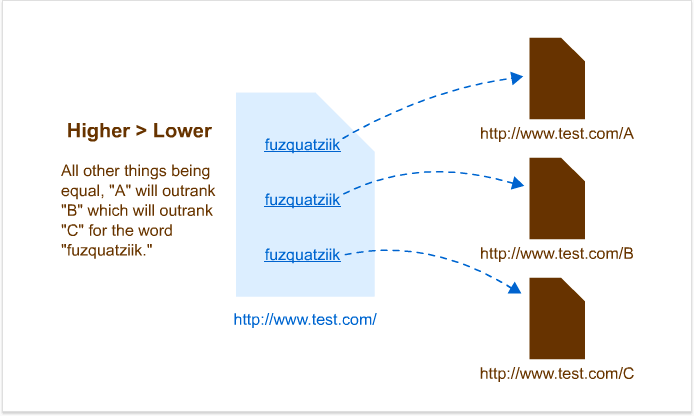
Note:
1. In case of multiple links to the same URL, Google will see all of them, but only the first link in HTML will matter in terms of passing ranking value.
2. Redirects and canonicals pass the same value as regular in-body links.
1. Following the recommendations of Google's patents, make sure your most important in-body links are placed higher on the page or on the list within the content.
2. Make sure your pages with valuable backlinks are not broken. Otherwise, all the value will be wasted. Go to SEO SpyGlass and create a project for your site. In Backlink Profile > Backlinks, check the Linked Page Status Code section for broken links:
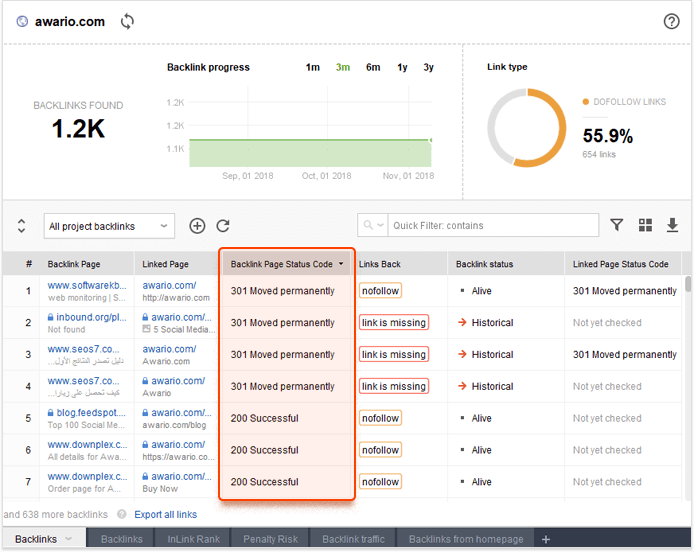
3. Make sure your important pages don't have any crawlability issues. WebSite Auditor can run a site audit for you to detect such issues. Create a project for your site in the tool. Go to Site Structure > Site Audit:
- Check the Indexing and crawlability section for 4xx/5xx status codes and pages restricted from indexing:

- Check for broken links:

- And pay attention to redirects and canonicals:

Myth #2. Image links are bad for SEO.
First of all, and I had to mention it earlier, every aspect, if abused, can be bad for SEO. The same goes for images.
Come on, there is no penalty for using image links. Of course, if image alt tags are stuffed with keywords to manipulate rankings, it’s indeed against Google's guidelines. Otherwise, you'll be good.
Not so long ago, Google found it difficult to read images. That's why their official position was like that:

However, with the quick evolution of AI, Google is getting better and better at understanding images (for example, with the help of Object Detection in images).
Plus, even if we take image's alt text and anchor text when the image is a link, what crawlers see is text. Thus, both text and images are translated into the same language in coding.
1. In spite of Google's efforts in the area of image recognition, it's still advisable not to leave image alt text blank. If you want to check for empty alt texts, use WebSite Auditor. Go to Site Structure > Site Audit > Images:
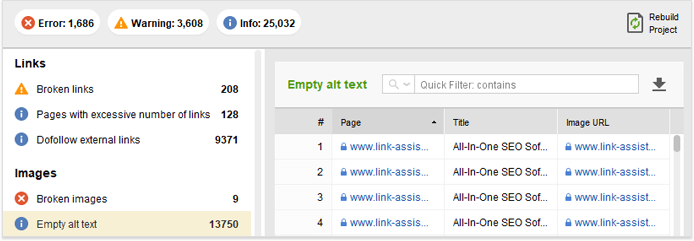
Do not worry, you don't have to fill in all alt texts. As a rule, it's important to do so for useful images like infographics, diagrams, screenshots of some process, etc.
2. General situations when you may want to link an image to another page are:
- Your image acts as a reference to another article or document;
- An image is an accompanying icon for a navigation link;
- It's an infographics or chart that needs to be zoomed in or viewed on a separate page.
Plus, when you link an image, never forget about a relevant caption and alt text.
3. Useful images are a great link building prospect. When you create unique infographics, charts, memes, etc., other sources can take them with a reference to your site.
Of course, not all of them will reference you. So, from time to time, go to your article, click on your great infographics, and select Search Google for image in a pop-up window. When you see that some sites use your image without a reference, ask them to resolve that misunderstanding:

Myth #3. All links should be rel=nofollow.
There are lots of recommendations on the web calling for making all links nofollow. Let's dig into this dangerous myth.
It's true a natural backlink profile has a considerable number of nofollow links (and sometimes even more than dofollow ones). At the same time, spammy websites can have up to 100% dofollow links. However, while without nofollow the web would sink in spam, most links on the web are still dofollow. Why? Proceed to Fact #2.
(Thanks to Mike Friedman for his input - the paragraph was edited according to his comment in the end of the article)
Nofollow links do not pass any value:

Now imagine all links are nofollow. They all have the same link quality. There is no domain authority. How would search engines evaluate sites? You see, making all your links nofollow can damage your SEO.
There were times of PageRank sculpting when people were afraid of linking out and losing their PageRank. It doesn't work now (and hasn't for quite some time already)! Look what Matt Cutts had to say in 2009:

What's more, PageRank is not the only part of ranking algo. And the trick with 200+ Google ranking factors is that you don’t need to optimize for each ?.
1. As a general rule, try to keep a balanced profile. Nofollow was introduced to cut on spam. Thus, set a nofollow rule for the comments section or any other place where people can add their own links.
2. Add a nofollow tag for those links that you want to keep but don"t want to be indexed (e.g., privacy policy). WebSite Auditor will show you which links on your site are dofollow/nofollow. Go to Site Structure > Pages, check Links from page and Links to page:
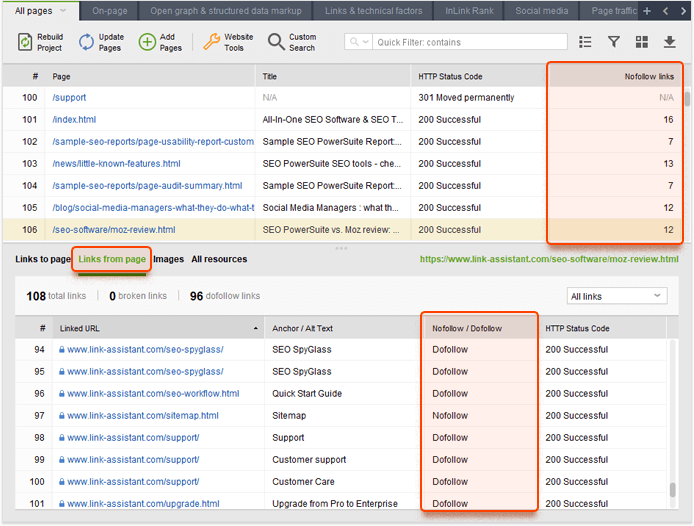
3. Check which of your backlinks are nofollow in SEO SpyGlass. Go to Backlink Profile > Backlinks > Links Back.
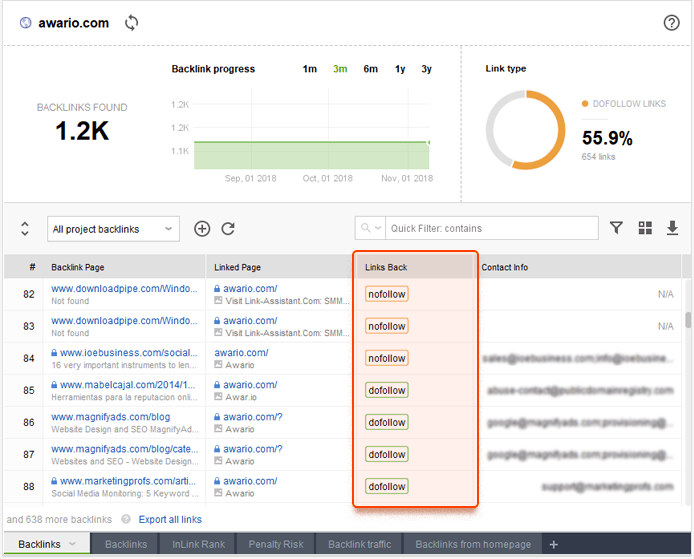
Using the Contact info section, write to the webmasters to ask whether there's any possibility to make your backlinks "follow".
Myth #4. Links from Wiki-like sites guarantee high rankings.
People believe that if they get a link from sites with exceptionally high authority, it will give them a ranking boost. I'm sorry, it is not true.
Google ranks Wikipedia and other similar sites just like everyone else on the web: by counting PageRank value of links to this particular page. Here is the information directly from Google:
Wikipedia is ranked just like any other website.
— Gary "鯨理" Illyes (@methode) December 16, 2016
Knowing that all sites are ranked according to the same factors, all you need to do is analyze links' PageRank. It's a known fact that access to Google's PageRank is now closed to public. However, SEO PowerSuite has developed an alternative to PageRank — InLink Rank. This metric reflects the ranking power of any page, and access to it is not closed:
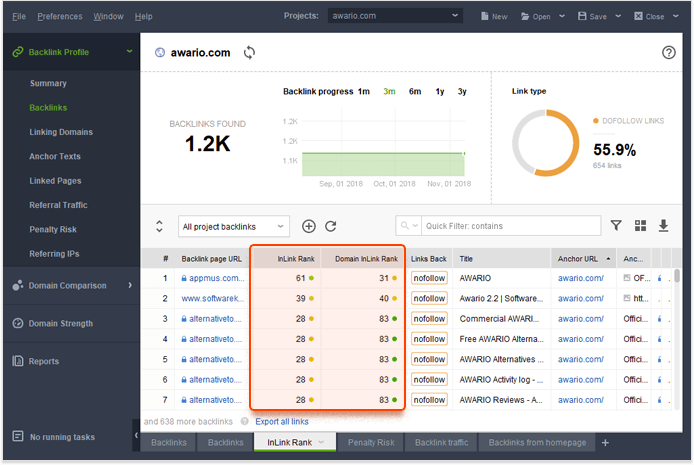
Myth #5: External links matter much more than internal ones.
Here I would rather say that internal and external links each carry their own importance.
While inbound links are one of the most important ranking factors, internal links play their own major role. First, by linking from higher to lower ranking pages, you give a link juice boost to your malnourished pages.
Second, by interlinking your content, you create so-called SEO topic clusters. In the age of semantic search, it's uber important. When Google comes to your site and finds out the whole topic cluster instead of one page, it considers you an expert in a particular field. This way, your site will be ranking much higher in search results.
1. To see which pages on your site have the highest and lowest authority, run WebSite Auditor and go to Site Structure > Visualization. Paint your graph by Internal Page Rank that reflects the importance and authority of a page within the site. The bigger the node, the more authority the page has.
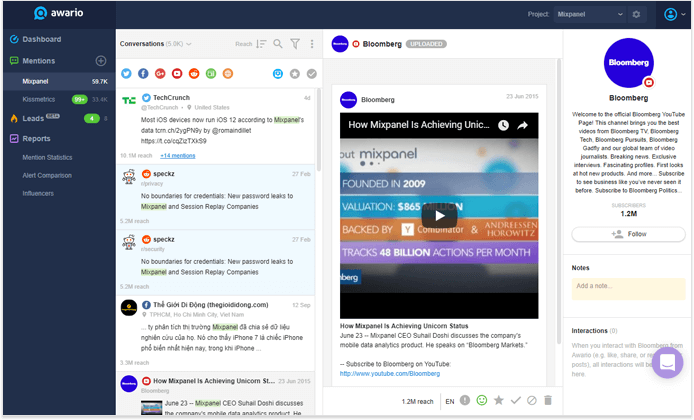
Now when you know which pages are the most powerful ones, you can link from them to weaker pages for some authority leverage.
2. If you need to check how your site is doing in terms of topical clustering, you can do it with the same Visualization tool. First go to Site Structure > Pages, search for a particular topic you know you have lots of content about. Filter it a bit and then tag appropriately.
Come back to the Visualization section, paint your graph by this tag clicking the palette button
, and see how you're doing in terms of topical clusters:
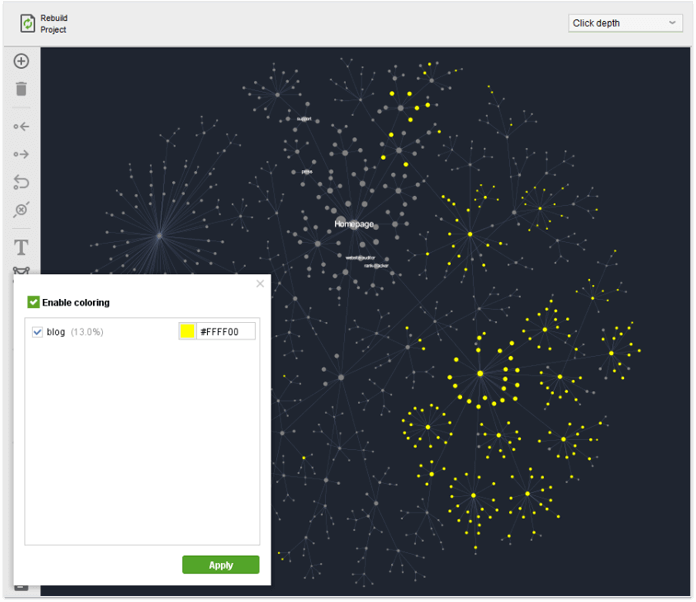
Myth #6. Links are the most important ranking factor.
Most probably, the myth goes back to this statement of Andrey Lipattsev, Google Search Quality Senior Strategist:

It's well-known there are about 200 ranking factors related to UX, mobile usability, technical performance, query intent, and many more.
Google's ranking factors are of very dynamic nature. The search engine selects ranking factors with the focus on a particular query's intent. John Mueller actually confirms it here.
So, links are very valuable, as they're one of the rare factors the effect of which is seen almost immediately. But it's wrong to think that Google ignores all the other factors to prioritize sites with amazing backlink profiles.
Backlinks being one of the most important factors call for regular checks. SEO SpyGlass has everything to make this process efficient.
First of all, the tool finds all the backlinks your site has. After that, you can check for dangerous backlinks with the help of the Penalty Risk metric.
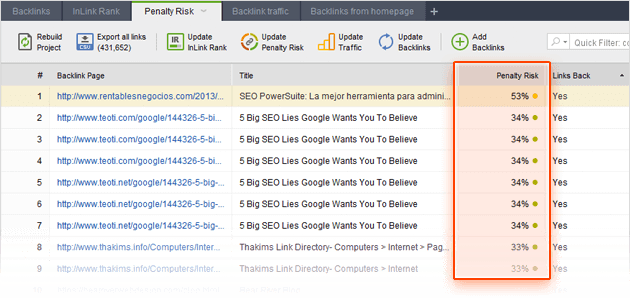
Second, it's possible to schedule regular checks in the tool. Go to Preferences > Scheduler and add the necessary task:
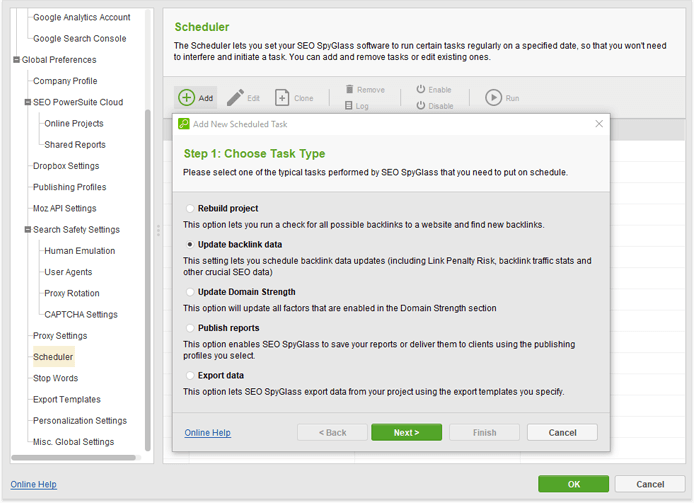
Myth #7. Links not relevant to your niche won’t help your site rank.
From time to time, I hear that non-relevant links are basically low-quality links. Let's see why it's not true.
Yes, we were taught that to rank high, we need relevant links. However, if it so happens that your site receives a non-relevant backlink, but it comes from a high authority site, there's no need to worry. Google will not frown upon such links if they are:
- Editorially given. Plus, in this scenario, it will be particularly hard for your competitors to get these links as well.
- From a local source. When it comes to a local business, links to your site may be coming from unexpected places: directories, local media, or your neighbor.
- From the niche indirectly relevant to your business. Imagine you have a farm, and you come up with an idea to rent some of your livestock. After some time, you find out that your business is listed in the health magazine's article on how to cope with stress (yes, rent some chicks! ?) You see, such backlinks can bring you new customers. And there's nothing to frown upon.
Myth #8: Guest posting for link building is dead.
The myth roots in this statement by Matt Cutts. And it's a good example of the importance to apply some logic to each piece of information you get.
The statement that guest posting is dead was later clarified. What Matt Cutts meant was spammy guest posting was dead. Indeed, why would search engines punish you if you publish your article on an authoritative platform with the aim of building your brand?
This way it's also safe to say that guest posting is not only about building links (as most of them will be made nofollow by a publisher), but building your brand and making it more visible. It's an indirect source of traffic flow. Plus, it's a nice way to decrease link-building cost.
1. First of all, when you think about a guest blogging option, check who's already talking about your or your competitor's brand. For that, use a social listening tool. You can try Awario, for example.
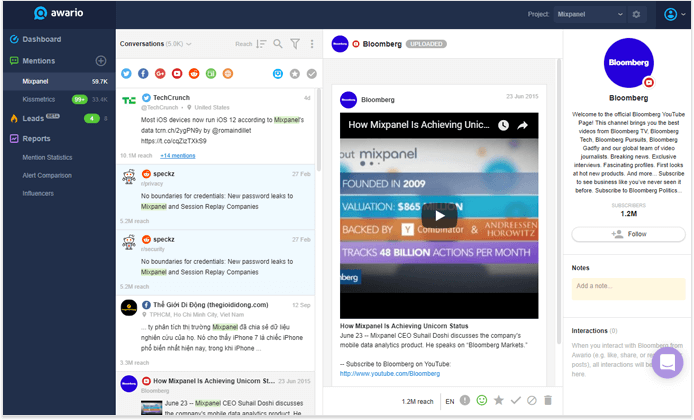
2. When some blog invites you to guest-post, check whether it posts quality content. Avoid guest-posting in spammy and thin-content blogs.
3. Besides links in bio, use contextual links even if they are nofollow.
4. Use guest blogging as a great opportunity to build your brand and reputation. Create quality content that resonates with readers. It's a great way to grow your link profile naturally.
In my opinion, these myths are the most dangerous ones. However, many more of them are roaming here and there. The best recipe to fight them is just to use your good judgment when you face a new myth, even if it’s coming from a reliable source.
Now I'm all set to read about the most dangerous link building myths according to your opinion. Let's meet in the comments.

By: Valerie Niechai







